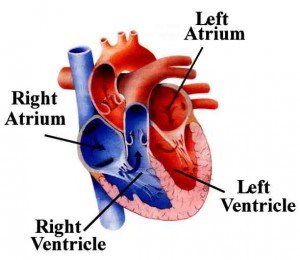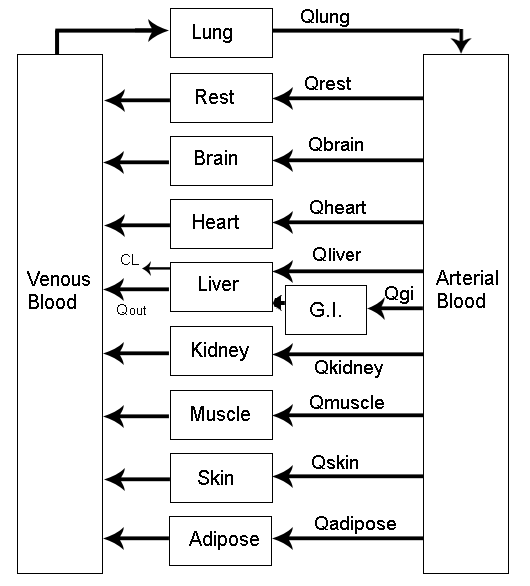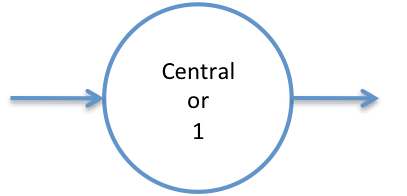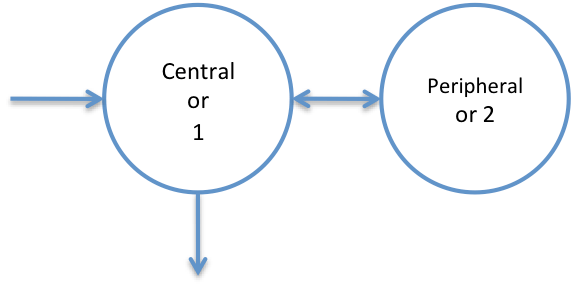Almost everyone familiar with pharmaceuticals has heard a conversation like this before:
Scientist 1: “What are the pharmacokinetics of Drug X?”
Scientist 2: “Drug X follows a 1-compartment model in rats, but in monkeys it tends to have a distribution phase and seems to follow 2-compartment kinetics.”
Scientist 1: Thinks to himself/herself …’What does a compartment have to do with this! A compartment is something you find in a train!’
Compartments are an important concept in pharmacokinetics (and pharmacodynamics), but they are rarely explained to other scientists. Hopefully this post will demystify the idea of compartments and show you that the concept of compartments is simple.

Human Heart
To understand compartments, think about your heart for a minute. A human heart has 4 distinct chambers, each with a specific function. Blood, which has been depleted of oxygen returns through the veins to the right atrium. It is then transferred to the right ventricle. The right ventricle pumps the blood into the lungs and then the blood moves into the left atrium. Finally the blood moves into the left ventricle which pushes the blood through the arteries of the body to distribute the oxygenated blood to all of the organs and tissues of the body. Each chamber of the heart has a specific function, and there is a specific flow of blood involved. The following schematic depicts the 4 chambers of the heart along with the direction of blood flow.

Heart Chambers Model
As you can see, the blood has unidirectional flow from one chamber to the next. In other words, the blood does not move from the right ventricle back into the right atrium (at least it doesn’t happen with a normal, healthy heart!). If this makes sense to you, then you now understand the idea of compartments. In a very real way, the chambers of the heart are separate “compartments” that the blood passes through.
In pharmacokinetics we don’t use tangible “compartments” like the chambers of the heart. Instead we use theoretical, or imaginary “compartments”. If you were to draw a picture of all the organs and tissues of the body, each as a separate compartment, it would look something like this (image from dougneubauer.com):

Physiologic-based PK model
Even this model is a bit simplistic for the body, are all muscles the same? What is the “Rest” of the body? Clearly, if we tried to identify every single different tissue in the body, we would have infinite “compartments” in our model. Pharmacokineticists like to simplify things significantly. Thus, instead of defining tangible compartments, we design theoretical compartments with *unique* names like 1, 2, 3, central, peripheral, etc. (I hope you noticed the sarcasm!). Then we draw arrows between these compartments to show how the drug travels from one compartment to the other. Here are 2 examples:

1-Compartment Model

2-Compartment Model
1-Compartment Model
- Drug enters the central compartment (or compartment 1) from somewhere outside of the body.
- Drug then leaves the central compartment. This is analogous to the drug leaving the body.
- Drug recirculation does not occur (output line does not reconnect with input line).
- The 1-compartment model considers the entire body, and all of the organs and tissues to be one giant bucket.
2-Compartment Model
- Drug enters the central compartment (or compartment 1) from somewhere outside of the body.
- Drug then leaves the central compartment by one of two paths:
- the peripheral compartment (also called compartment 2) or
- drug leaves the body
- Drug that is in the peripheral compartment can return to the central compartment.
- Drug recirculation occurs between the central and peripheral compartment, but once drug leaves the body, it does not re-enter the body.
- The 2-compartment model considers the entire body, and all of the organs and tissues to be two buckets, but all drug must leave the body through a single bucket.
In many ways the compartmental models are very similar to the heart chamber model. These models show movement from one “chamber” to another. The 2 key differences are that the pharmacokinetic models are not closed systems (drug is not recirculated from output to input); and pharmacokinetic models permit bi-directional movement (the heart chamber model only allows unidirectional movement).
Hopefully you now understand what is meant by compartmental models in pharmacokinetics. In essence, the number (1, 2, 3) refers to the number of circles drawn on the paper. Many may be asking why we use compartment models in pharmacokinetics. The brief answer is that the mathematical functions associated with compartment models seem to describe the observed data very well. It is for practical reasons, not physiologic reasons that we use compartmental models. I will leave the detailed explanation for another blog post.
表征化合物药代动力学(PK)和药效学(PD)的方法可能本身就很复杂和精密。PK/PD 分析是一门科学,需要数学和统计学背景以及对生物学、药理学和生理学的了解。PK/PD 分析为药物开发中的关键决策提供指导,如优化剂量、频率和暴露持续时间,因此正确做出这些决策至关重要。选择决策工具同样重要。幸运的是,PK/PD 分析软件近年来有了很大的发展,使用户可以专注于分析,而不是算法和编程语言。
Access your free PK/PD resource
Authored by Prof. Johan Gabrielsson, this trusted eBook provides comprehensive insights into pharmacokinetics and pharmacodynamics. Simply register with your professional or academic email to access the standard book “Pharmacokinetic and Pharmacodynamic Data Analysis” – completely free!




